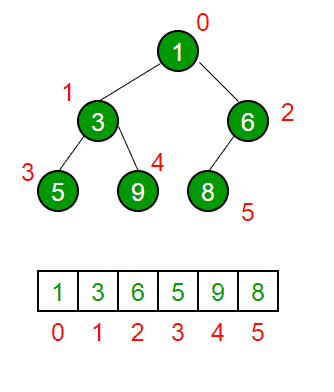二进制堆是具有以下属性的二叉树。 1) 这是一个完整的树(除了最后一个级别,所有级别都被完全填充,最后一个级别尽可能地保留所有关键点)。二进制堆的这个特性使它们适合存储在数组中。
2) 二进制堆是最小堆或最大堆。在最小二进制堆中,根上的密钥必须是二进制堆中所有密钥中的最小密钥。对于二叉树中的所有节点,相同的属性必须递归为真。最大二进制堆类似于最小堆。
最小堆的示例:
10 10
/ /
20 100 15 30
/ / /
30 40 50 100 40
二进制堆是如何表示的? 二进制堆是一个完整的二叉树。二进制堆通常表示为数组。
- 根元素将位于Arr[0]。
- 下表显示了i的其他节点的索引 th 节点,即Arr[i]:
Arr[(i-1)/2] 返回父节点 Arr[(2*i)+1] 返回左子节点 Arr[(2*i)+2] 返回正确的子节点 用于实现数组表示的遍历方法是 水平顺序

请参考 二进制堆的数组表示 详细信息。
堆的应用: 1) 堆排序 :Heap Sort使用二进制堆在O(nLogn)时间内对数组进行排序。
2) 优先级队列:使用二进制堆可以有效地实现优先级队列,因为它支持在O(logn)时间内执行insert()、delete()和extractmax()、decreaseKey()操作。二进制堆和斐波那契堆是二进制堆的变体。这些变体也能有效地执行联合。
3) 图算法:优先级队列特别用于图算法,如 Dijkstra的最短路径 和 普里姆最小生成树 .
4) 使用堆可以有效地解决许多问题。例如,见下文。 (a) 数组中第K个最大元素 . b) 对几乎排序的数组进行排序/ c) 合并K排序数组 .
最小堆上的操作: 1) getMini():它返回Min Heap的根元素。该操作的时间复杂度为O(1)。
2) extractMin():从MinHeap中删除最小元素。此操作的时间复杂度为O(Logn),因为此操作需要在删除根后(通过调用heapify())维护heap属性。
3) decreaseKey():减少键的值。该操作的时间复杂度为O(Logn)。如果一个节点的reduces键值大于该节点的父节点,那么我们不需要做任何事情。否则,我们需要遍历up来修复违反的heap属性。
4) insert():插入新密钥需要O(Logn)时间。我们在树的末尾添加一个新键。如果新密钥大于其父密钥,则无需执行任何操作。否则,我们需要遍历up来修复违反的heap属性。
5) delete():删除密钥也需要O(Logn)时间。我们通过调用decreaseKey()将要删除的密钥替换为minum infinite。在decreaseKey()之后,负无穷大的值必须到达根,所以我们调用extractMin()来移除该键。
下面是基本堆操作的实现。
C++
// A C++ program to demonstrate common Binary Heap Operations#include<iostream>#include<climits>usingnamespacestd;// Prototype of a utility function to swap two integersvoidswap(int*x,int*y);// A class for Min HeapclassMinHeap{int*harr;// pointer to array of elements in heapintcapacity;// maximum possible size of min heapintheap_size;// Current number of elements in min heappublic:// ConstructorMinHeap(intcapacity);// to heapify a subtree with the root at given indexvoidMinHeapify(int);intparent(inti) {return(i-1)/2; }// to get index of left child of node at index iintleft(inti) {return(2*i + 1); }// to get index of right child of node at index iintright(inti) {return(2*i + 2); }// to extract the root which is the minimum elementintextractMin();// Decreases key value of key at index i to new_valvoiddecreaseKey(inti,intnew_val);// Returns the minimum key (key at root) from min heapintgetMin() {returnharr[0]; }// Deletes a key stored at index ivoiddeleteKey(inti);// Inserts a new key 'k'voidinsertKey(intk);};// Constructor: Builds a heap from a given array a[] of given sizeMinHeap::MinHeap(intcap){heap_size = 0;capacity = cap;harr =newint[cap];}// Inserts a new key 'k'voidMinHeap::insertKey(intk){if(heap_size == capacity){cout <<"Overflow: Could not insertKey";return;}// First insert the new key at the endheap_size++;inti = heap_size - 1;harr[i] = k;// Fix the min heap property if it is violatedwhile(i != 0 && harr[parent(i)] > harr[i]){swap(&harr[i], &harr[parent(i)]);i = parent(i);}}// Decreases value of key at index 'i' to new_val. It is assumed that// new_val is smaller than harr[i].voidMinHeap::decreaseKey(inti,intnew_val){harr[i] = new_val;while(i != 0 && harr[parent(i)] > harr[i]){swap(&harr[i], &harr[parent(i)]);i = parent(i);}}// Method to remove minimum element (or root) from min heapintMinHeap::extractMin(){if(heap_size <= 0)returnINT_MAX;if(heap_size == 1){heap_size--;returnharr[0];}// Store the minimum value, and remove it from heapintroot = harr[0];harr[0] = harr[heap_size-1];heap_size--;MinHeapify(0);returnroot;}// This function deletes key at index i. It first reduced value to minus// infinite, then calls extractMin()voidMinHeap::deleteKey(inti){decreaseKey(i, INT_MIN);extractMin();}// A recursive method to heapify a subtree with the root at given index// This method assumes that the subtrees are already heapifiedvoidMinHeap::MinHeapify(inti){intl = left(i);intr = right(i);intsmallest = i;if(l < heap_size && harr[l] < harr[i])smallest = l;if(r < heap_size && harr[r] < harr[smallest])smallest = r;if(smallest != i){swap(&harr[i], &harr[smallest]);MinHeapify(smallest);}}// A utility function to swap two elementsvoidswap(int*x,int*y){inttemp = *x;*x = *y;*y = temp;}// Driver program to test above functionsintmain(){MinHeap h(11);h.insertKey(3);h.insertKey(2);h.deleteKey(1);h.insertKey(15);h.insertKey(5);h.insertKey(4);h.insertKey(45);cout << h.extractMin() <<" ";cout << h.getMin() <<" ";h.decreaseKey(2, 1);cout << h.getMin();return0;}python
# A Python program to demonstrate common binary heap operations# Import the heap functions from python libraryfromheapqimportheappush, heappop, heapify# heappop - pop and return the smallest element from heap# heappush - push the value item onto the heap, maintaining# heap invarient# heapify - transform list into heap, in place, in linear time# A class for Min HeapclassMinHeap:# Constructor to initialize a heapdef__init__(self):self.heap=[]defparent(self, i):return(i-1)/2# Inserts a new key 'k'definsertKey(self, k):heappush(self.heap, k)# Decrease value of key at index 'i' to new_val# It is assumed that new_val is smaller than heap[i]defdecreaseKey(self, i, new_val):self.heap[i]=new_valwhile(i !=0andself.heap[self.parent(i)] >self.heap[i]):# Swap heap[i] with heap[parent(i)]self.heap[i] ,self.heap[self.parent(i)]=(self.heap[self.parent(i)],self.heap[i])# Method to remove minium element from min heapdefextractMin(self):returnheappop(self.heap)# This functon deletes key at index i. It first reduces# value to minus infinite and then calls extractMin()defdeleteKey(self, i):self.decreaseKey(i,float("-inf"))self.extractMin()# Get the minimum element from the heapdefgetMin(self):returnself.heap[0]# Driver pgoratm to test above functionheapObj=MinHeap()heapObj.insertKey(3)heapObj.insertKey(2)heapObj.deleteKey(1)heapObj.insertKey(15)heapObj.insertKey(5)heapObj.insertKey(4)heapObj.insertKey(45)printheapObj.extractMin(),printheapObj.getMin(),heapObj.decreaseKey(2,1)printheapObj.getMin()# This code is contributed by Nikhil Kumar Singh(nickzuck_007)C#
// C# program to demonstrate common// Binary Heap Operations - Min HeapusingSystem;// A class for Min HeapclassMinHeap{// To store array of elements in heappublicint[] heapArray{get;set; }// max size of the heappublicintcapacity{get;set; }// Current number of elements in the heappublicintcurrent_heap_size{get;set; }// ConstructorpublicMinHeap(intn){capacity = n;heapArray =newint[capacity];current_heap_size = 0;}// Swapping using referencepublicstaticvoidSwap<T>(refT lhs,refT rhs){T temp = lhs;lhs = rhs;rhs = temp;}// Get the Parent index for the given indexpublicintParent(intkey){return(key - 1) / 2;}// Get the Left Child index for the given indexpublicintLeft(intkey){return2 * key + 1;}// Get the Right Child index for the given indexpublicintRight(intkey){return2 * key + 2;}// Inserts a new keypublicboolinsertKey(intkey){if(current_heap_size == capacity){// heap is fullreturnfalse;}// First insert the new key at the endinti = current_heap_size;heapArray[i] = key;current_heap_size++;// Fix the min heap property if it is violatedwhile(i != 0 && heapArray[i] <heapArray[Parent(i)]){Swap(refheapArray[i],refheapArray[Parent(i)]);i = Parent(i);}returntrue;}// Decreases value of given key to new_val.// It is assumed that new_val is smaller// than heapArray[key].publicvoiddecreaseKey(intkey,intnew_val){heapArray[key] = new_val;while(key != 0 && heapArray[key] <heapArray[Parent(key)]){Swap(refheapArray[key],refheapArray[Parent(key)]);key = Parent(key);}}// Returns the minimum key (key at// root) from min heappublicintgetMin(){returnheapArray[0];}// Method to remove minimum element// (or root) from min heappublicintextractMin(){if(current_heap_size <= 0){returnint.MaxValue;}if(current_heap_size == 1){current_heap_size--;returnheapArray[0];}// Store the minimum value,// and remove it from heapintroot = heapArray[0];heapArray[0] = heapArray[current_heap_size - 1];current_heap_size--;MinHeapify(0);returnroot;}// This function deletes key at the// given index. It first reduced value// to minus infinite, then calls extractMin()publicvoiddeleteKey(intkey){decreaseKey(key,int.MinValue);extractMin();}// A recursive method to heapify a subtree// with the root at given index// This method assumes that the subtrees// are already heapifiedpublicvoidMinHeapify(intkey){intl = Left(key);intr = Right(key);intsmallest = key;if(l < current_heap_size &&heapArray[l] < heapArray[smallest]){smallest = l;}if(r < current_heap_size &&heapArray[r] < heapArray[smallest]){smallest = r;}if(smallest != key){Swap(refheapArray[key],refheapArray[smallest]);MinHeapify(smallest);}}// Increases value of given key to new_val.// It is assumed that new_val is greater// than heapArray[key].// Heapify from the given keypublicvoidincreaseKey(intkey,intnew_val){heapArray[key] = new_val;MinHeapify(key);}// Changes value on a keypublicvoidchangeValueOnAKey(intkey,intnew_val){if(heapArray[key] == new_val){return;}if(heapArray[key] < new_val){increaseKey(key, new_val);}else{decreaseKey(key, new_val);}}}staticclassMinHeapTest{// Driver codepublicstaticvoidMain(string[] args){MinHeap h =newMinHeap(11);h.insertKey(3);h.insertKey(2);h.deleteKey(1);h.insertKey(15);h.insertKey(5);h.insertKey(4);h.insertKey(45);Console.Write(h.extractMin() +" ");Console.Write(h.getMin() +" ");h.decreaseKey(2, 1);Console.Write(h.getMin());}}// This code is contributed by// Dinesh Clinton Albert(dineshclinton)输出:
2 4 1
堆上的编码实践 堆上的所有文章 堆上测验 PriorityQueue:Java库中的二进制堆实现
如果您发现任何不正确的地方,或者您想分享有关上述主题的更多信息,请写下评论。


![关于”PostgreSQL错误:关系[表]不存在“问题的原因和解决方案-yiteyi-C++库](https://www.yiteyi.com/wp-content/themes/zibll/img/thumbnail.svg)



